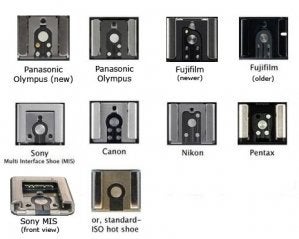- Messages
- 34
- Name
- Phil
- Edit My Images
- Yes
Is it ok to use a Canon flash on an Olympus camera? I’m switching systems and while waiting to buy an Olympus flash found the Canon works perfectly..obviously manual flash only. could I do any damage?

That’s so informative and great news for me till I can get Olympus flashes and triggers..I much prefer manual flash any way, thank you so much.I read this post on another forum, I hope it may be of help to you?
Any ISO-compliant flash will fire on any ISO-compliant hotshoe (so long as the sync voltage is safe).
The sync voltage issue is stated in a somewhat alarmist fashion, because you can fry your camera hotshoe and that's not a minor issue. But it's a rare combination of events that will cause that, and it doesn't happen with digital-era flash gear, only vintage film-era flash gear. So as long the model of flash you're using has been made for digital, you're safe.
The "ISO-compliant" bit is easier to explain with a picture:
The ISO standard pretty much says that all flash hotshoes have to have a certain shape and size (so everything can physically fit), and that electronically, the rails (the two side pieces of metal) are ground, and that the big contact in the center of the "square" is going to be the sync ("fire!") signal, and that communicating that signal is shorting sync to ground.
So, the practical upshot is you can use any of the flashes that fit any of these hotshoes in each other, and the flash will fire in sync with the shutter being released. But that's all you get. The other electrical contacts are all proprietary and can shift in placement and number, and the signal protocol behind those contacts is different for every brand. So features like TTL, HSS, camera menu control, etc. are not going to work cross-brand.
The actual post is here: https://www.fujix-forum.com/threads/flash-options-for-macro-photography.80816/
Looks like ill have to keep my Canon equipment then till I can afford olympus flash system. I really don’t want to take any chances.The difference between the Olympus 3 and 4 pin hotshoe versions is the extra pin supplies constant voltage to power those flashes which have no internal power supply, like the small bundled flashes. There might be a risk with certain flashes of feeding a constant supply of volts that the flash is not expecting from the extra pin. I've not heard of any particular combinations causing problems but err on the side of caution myself and do not use my Canon compatible flashes on my Olympus cameras.
In the past there were no wireless flash triggers for Olympus, the only option was to use their own optical communication to remote flashes which does not work too well in more than subdued lighting and had a limited range. Godox and Hahnel have introduced true wireless comms which support TTL and HSS on compatible remote flashes, I have no experience of either of these. The older Olympus flashes FL-36 and FL-50 crop up at very reasonable prices these days (less than a new Godox flash), each flash has two versions, remote optical support or no remote support. Remote support is indicated by the letters 'RC' on the front of the flash, I have both flashes in the 'RC' version. The FL-36 flash is better balanced on smaller cameras but only has 2 batteries and is slower to recharge, but both are very good flash units. Optical support is better than nothing, but I revert to my Canon DSLR when I need actual wireless capability, via Yongnuo YN 622C remotes which are ultra reliable.
